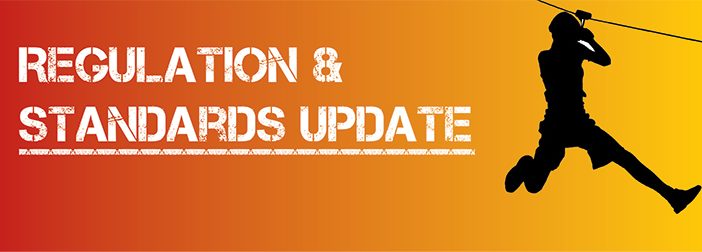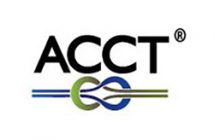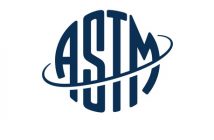It’s a busy time for standards and regulations. At press time, several developments were in the works:
• ASTM was balloting new language regarding the scope of the ASTM F2959 standard, once again aiming to eliminate the exclusions for educational, therapeutic, physical fitness, teambuilding, and other “non-commercial” operations.
• ACCT was nearing completion of work on a new edition of the ANSI/ACCT standard.
• PRCA was working to refresh the ANSI/PRCA standard, which is now in its fifth year, and in need of updating.
• Colorado was considering new rules for aerial parks, Utah passed and signed into law an amusement park standard—the state’s first—including aerial adventure parks, and North Carolina was considering two regulatory bills.
• ACCT’s operations accreditation program, which can be seen as a sort of “voluntary standard,” was moving forward and approaching a launch date.
ANSI/ACCT 03-2016 STANDARD
The new edition of the ANSI/ACCT standard, currently nearing adoption, contains some key revisions. Perhaps the biggest: a revamped operations section.
A session at the ACCT Conference in February pointed out that the changes stemmed from the goal of creating an effective standard for commercial parks. The original ANSI/ACCT standard didn’t really address aerial adventure parks; the new edition has an entire section related to them.
The new standard prescribes practices based on the operating system used on the course. It more clearly delineates the requirements for different types of activities, such as aerial trekking, zip lines, facilitated programs, etc. That should make it easier to follow, and to find the relevant info for a particular operation.
For example, the function of monitors is more clearly defined; the standard includes a chart that details the level of monitoring needed for different types of safety equipment (lobster claws, smart belays, etc.).
Some language has been incorporated from OSHA, primarily in sections that apply to employees and PPE.
The new edition also contains small revisions to design, performance, and inspection sections, primarily editing changes to clarify particular points and make the standard easier to understand.
To make the standard less costly to produce, and thus easier for operators to buy, ACCT is removing some ancillary materials from the standard, such as practitioner certification, and publishing these separately.
ACCT expected to submit its BSR9 form to ANSI, seeking ANSI’s approval of the development process, by mid-April. Pending approval, the new edition of the standard could be published soon.
Consensus meetings. ACCT is already working on revisions for the subsequent edition of the standard. ACCT has posted the dates for upcoming consensus meetings, at which members can hear about and comment on proposed changes, on the ACCT website. “We want people to take part, so they understand the process and get involved,” says Scott Andrews, ACCT policy director and secretary for the Consensus Group. “That’s how we get a better standard.”
One task group is working on operating at height, to align the ANSI/ACCT standard with OSHA regulations and bridge gaps between the two. The current ACCT standard omits workers at height; it applies to participants only. On the other hand, OSHA regulations are aimed at the construction industry, and don’t always translate smoothly to the aerial adventure world.
Harnesses are a point of focus. Language currently under consideration will spell out when less than a full harness for staff as well as participants is appropriate, and when something more is required. Certain body types, or circumstances in which participants can be put into difficult situations, may dictate use of more than a seat harness.
ASTM F2959-18
On March 22, ASTM F2959 Evolution Task Group head Jeff Borba initiated a ballot on the revision of ASTM F2959-18 regarding the scope of the standard. Last October, the Evo task group had proposed eliminating the exclusion of many “non-commercial” aerial operations from the F2959 standard. After members of ACCT and PRCA raised objections to some of the language, the F2959 committee agreed to table that proposal for a year.
However, the task group assigned to work on alternative language regarding the exclusion had made little apparent progress. So, following comments received at the ASTM meetings in February, Borba drafted new language intended to reflect those comments and submitted it to ballot. The voting period was to end April 22.
The main change was the addition of a section under “Scope” that reads, “Scope of this practice does not specifically address all human factors, particularly those intrinsic in certain educational curriculum; physical fitness, therapeutic, training and team and confidence building programs; and organized competitive events.”
The new ballot caught many in the aerial adventure world by surprise, since they thought new language would be considered at the ASTM meetings next October. Some were less than pleased by the March ballot.
PRCA president Mike Barker, the industry lead for the scope revision, conducted a working session on the scope language at the PRCA conference in early March. He told Adventure Park Insider that his task group discussed several possible language options, which he planned to describe in his ballot.
Though the balloted language was quite different from what his group was pursuing, Barker suggested the ballot language might be acceptable, if it referenced the ANSI/ACCT and ANSI/PRCA standards for the cited activities.
ACCT was preparing a formal response to the ballot as we went to press.
In an email to voting members, F2959 chairman Jared Krupa said, “To clarify, if this ballot is supported, it will replace the original scope revision document and move forward to publication, and if it is rejected, then the task group will consider both the original and new drafts and decide how to move forward.” The ballot will be taken up at the ASTM F24 meetings in October.
In the meantime, work continues on several other aspects of ASTM F2959-18, including braking, wire rope, geotechnical requirements, updates to the F1193 standard, SARC test, via ferrata testing, and auditing requirements.
Krupa said that input on the scope ballot should be directed to Borba at [email protected]. Questions about other revisions can go to Krupa at [email protected].
Krupa, Barker, and ACCT policy director Scott Andrews all urged interested non-members to join the organization and participate in future activities of the F24 committee and the F2959 task groups. For general questions about ASTM International/F24 and membership contact Katerina Koperna at [email protected].
On a related note, Krupa, Barker, and Andrews all said that work on harmonizing all three standards—ASTM F2959, ANSI/ACCT and ANSI/PRCA—has been progressing. The aim, Andrews said, is to “find and fix the blind spots in each of the three standards,” and tailor them “to suit the industry across the spectrum, from amusement parks to experiential, educational, and therapeutic programs.”
ACCT OPERATION ACCREDITATION
The long-considered ACCT operation accreditation program is coming closer to fruition. While some details remain, not the least of which are cost and how to certify the program’s reviewers, the outlines are becoming clearer.
Accreditation will involve an on-site inspection and a review of operations and training. Much of that revolves around the operations section of the ANSI/ACCT standard. Accreditation will be based on a review of documentation of procedures and training, as well as a review of the operation in action.
At the ACCT Conference, ACCT policy director Scott Andrews emphasized that the inspection is not a simple “pass/fail” test, as an operator would have a limited amount of time to correct deficiencies and still become accredited. But he also emphasized the importance of reviewing the requirements and correcting any deficiencies before initiating the review process, as that can vastly speed the timeline and reduce the potential for headaches.
“I hope this process helps people learn whether what they are doing is acceptable, but also learn what they could do better. The aim is to raise the bar,” he said.
ANSI/PRCA 1.0-.3-2014
This is the five-year anniversary of the ANSI/PRCA standard, and as such, it is due for renewal. A PRCA consensus group is working on that project. PRCA president Mike Barker encourages interested parties, both vendors and operators, to join the effort. Some of that involves simple edit changes, but some sections—such as emergency braking—are more involved. “We want to expand on emergency braking and other areas to reflect and update the standard, to take account of changes and innovations in the industry,” Barker said. The effort will also include harmonizing the ANSI/PRCA standard with ASTM and ANSI/ACCT where possible, he added.
STATE NEWS
Colorado is updating its amusement rides and devices regulations, which specify application of the ASTM F2959-18 standard for aerial adventure courses and zip lines. A stakeholders meeting was scheduled for April 1 (no kidding). The regulations, administered by the Division of Oil and Public Safety in the Department of Labor and Employment, include requirements for daily and annual inspections and recordkeeping for same, and a provision for reporting injuries caused by the malfunction or failure of a ride or device, or by operator or patron error. Proposed effective date is June 15, 2019.
The Utah legislature has passed the Amusement Ride Safety Act, regulating amusement rides and zip lines in the state for the first time. Utah had been one of six states with no regulations for amusement parks. The bill has been in the works since early 2019, and moved swiftly through both houses of the legislature. It arrived on the Governor’s desk for signing into law on March 22.
Among the bill’s provisions, it specifies that ASTM F24 Committee standards will apply (for aerial parks, that means ASTM F2959). It also details annual and daily inspections, insurance requirements, and other activities. The provisions are to take effect in April 2021. The bill gives authority for the regulations to the Utah Department of Transportation. The department also oversees the Utah Passenger Ropeway Safety Committee, which regulates the operation of ski lifts. The amusement park bill was modeled after the lift regulatory system.
The North Carolina House is currently home to two competing bills, neither of which appears close to adoption. One, HR 380, would require daily and annual inspections, injury reporting, and adherence to ACCT, PRCA, ERCA (European Ropes Course Association) or ASTM standards, depending on which is or had been followed during construction. That bill has failed to move beyond the Judiciary Committee. A second bill, HR 395, is much simpler, and specifies adherence to ANSI/ACCT. It was first submitted to Judiciary for consideration on March 21. •






